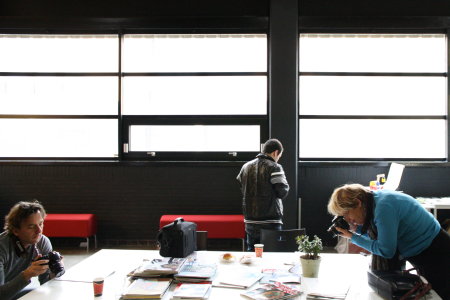DSLR photography workshop
When I bought my Canon EOS 1000D camera earlier this year I got a coupon that allowed me to participate in a photography workshop (EOS is their range of so-called Single Lens Reflexes, the D stands for digital, and the large number signifies the entry level model).
For 25 euro, a man told us everything about using this camera model during about 5 hours. As the workshop started at 10 am, and there were several breaks including one for lunch, the workshop almost spanned an entire working day.
Since it’s been awhile, I’ll just list what I thought was good and what was not so good.
The Good:
– Information filled: I actually learned quite a bit.
– The price? I would probably not have signed up if the workshop had cost four times more.
– There were a number of sessions where we got to put the things we had just learned into practice.
– The institute provided drinks and a simple lunch, which made the whole affair seem just that much more thought out. During the breaks, the instructor was available for questions.
The Not-so-good:
– Read the manual out loud: the bulk of the workshop consisted of going over almost the complete feature set of the camera. This turned out to be necessary: some of the students hadn’t bothered reading the manual. But since I myself had bothered to read the manual, I could have done with more of ‘how to use these features to make great photos.’
– The teacher sometimes reverted to sarcasm; it sounded like he needed a vacation. If you cannot treat your customers with civility, why bother showing up? (Then again, this was at the end of the day, perhaps he was getting tired.)
– Large chunks of the presentation were accompanied by bog standard Powerpoint presentation, i.e. reams of text on an overhead projector. Good presentations involve powerful imagery to make an emotional connection with what the presenter is trying to stay. It strikes me that if anything is suited for good Powerpoint, it would be a photography workshop. I want to be able to see what I can achieve by using the camera in a certain way.
– The price? Especially at the end of the day the crowd started getting noisy and restless, making it difficult to follow what the instructor was saying. I figured people would have been more attentive if they had had to pay more. But perhaps it wasn’t the price of the exercise, but the duration and nature that caused a restless audience.
If I could have changed one thing about the underlying idea of this course, it would have been to offer two workshops, one for people who already had read the manual, and one for people who had not.
Summing up, the workshop was worth the money, but it could have been much more vibrant. Whether it’s worth it for you depends largely on the amount of time you can spare; the price is hardly an object.

Leave a Reply